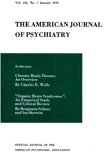Twin Interactions in a Normal Nursery School
Abstract
The authors studied ten sets of middle-class fraternal twins in an effort to determine what factors influenced the twinning relationship. They found that five sets of twins showed some form of mutual dependency and that two showed one-sided dependency; in each case mother-child dependency was excessive. Three pairs of twins showed minimal or no dependency. Each of these groups is illustrated with a case report. Follow-up of six sets of twins revealed an unexpectedly high incidence of neurotic problems that were not significantly related to dependency. The authors offer several possible explanations for this finding.
Access content
To read the fulltext, please use one of the options below to sign in or purchase access.- Personal login
- Institutional Login
- Sign in via OpenAthens
- Register for access
-
Please login/register if you wish to pair your device and check access availability.
Not a subscriber?
PsychiatryOnline subscription options offer access to the DSM-5 library, books, journals, CME, and patient resources. This all-in-one virtual library provides psychiatrists and mental health professionals with key resources for diagnosis, treatment, research, and professional development.
Need more help? PsychiatryOnline Customer Service may be reached by emailing [email protected] or by calling 800-368-5777 (in the U.S.) or 703-907-7322 (outside the U.S.).



